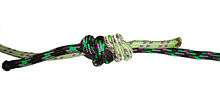Double fisherman's knot
| Double Fisherman's knot | |
|---|---|
 | |
| Names | Double Fisherman's knot, Grapevine, Double englishman's knot |
| Category | Bend |
| Origin | Ancient |
| Related | Fisherman's knot, Triple fisherman's knot, Double overhand knot, Strangle knot |
| Releasing | Jamming |
| Typical use | Joining thin, stiff or slippery lines, backing up critical knots such as the Figure-of-eight loop or Figure-of-eight follow through |
| Caveat | Difficult to untie |
| ABoK | #294, #1415 |
The double fisherman's knot or grapevine knot is a bend, or a knot used to join two lengths of rope. This knot and the triple fisherman's knot are the variations used most often in climbing, arboriculture, and search and rescue. The knot is formed by tying a double overhand knot, in its strangle knot form, with each end around the opposite line's standing part.
Usage
A primary use of this knot is to form high strength (round) slings of cord for connecting pieces of a climber's protection system.
Other uses
This knot, along with the basic fisherman's knot can be used to join the ends of a necklace cord. The two strangle knots are left separated, and in this way the length of the necklace can be adjusted without breaking or untying the strand.
Tying
Line form
Drop form
Security
Dyneema/Spectra's very high lubricity leads to poor knot-holding ability, and has led to the recommendation to use the triple fisherman's knot rather than the traditional double fisherman's knot in 6mm Dyneema core cord to avoid a particular failure mechanism of the double fisherman's, where first the sheath fails at the knot, then the core slips through.[1][2]
A study of 8 different bends using climbing ropes concluded "The Double Fisherman's Knot seemed to be the best joining knot." The Butterfly bend held under slightly more weight, but "almost impossible to untie after a significant load of about 1,000 lbs. was applied."[3]







